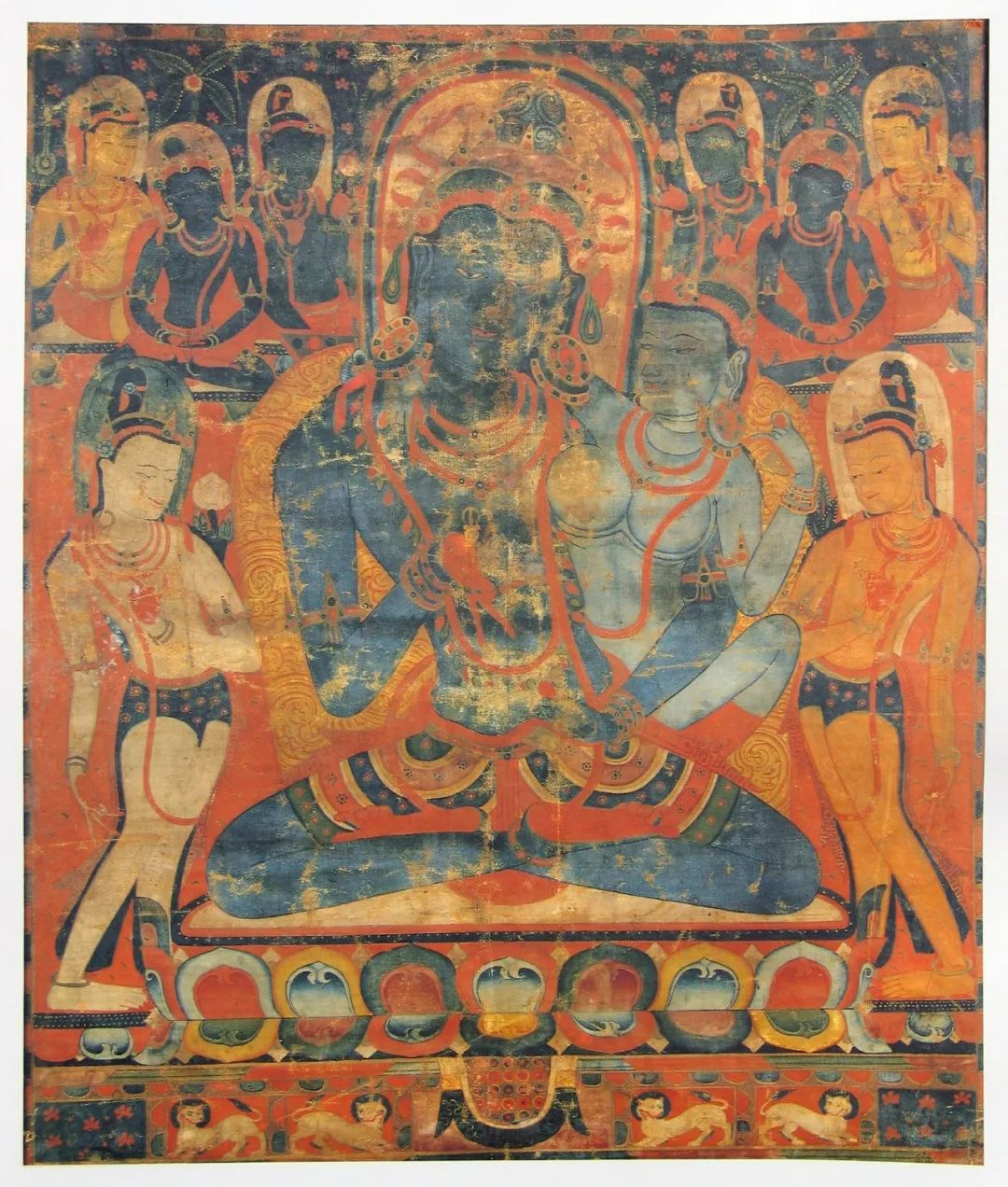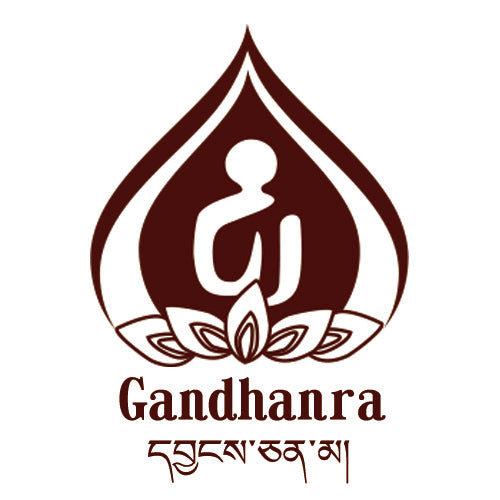
Blue in Himalayan art: The nectar of liberation in the depths of the mysterious realm

"Three Medicine Buddha Statues", 14th century, private collection
With the pure and untainted blue light shining throughout the three thousand worlds,
He is honored with the title of "Lapis Lazuli Light" (བཻཌཱུརྱ་འོད་),
The color of lapis lazuli is known as "indigo blue" (མཐིང་རམས་),
Also known as the pure and colorless lapis lazuli gemstone.
The blue color is the immaculate and healing color of Medicine Buddha,
Symbolizing various medicinal materials and tools.

Localized: Blue opal body color

"Pharmacist Yutuo", 18th century, private collection
In the writings of Yutok Yonten Gonpo (1171-1246), he associates the color blue with healing.
From light blue (མཐིང་སྐྱ་) to dark blue (མཐིང་ཆེན་), each shade symbolizes different stages of healing.

"The East Parents of Amida Buddha", 14th century, Museum of Gemi
Buddha of the East (also known as the Immobile Tathagata)
His body color is blue-black (མཐིང་ནག་; similar to navy blue)
In later Mahayana sutras, this body color is referred to as "the color of the round mirror"
(མེ་ལོང་གི་མདངས་; displaying all colors)
The Buddha's mind is as unmoving as the sky and the ocean
Therefore, the color blue is also considered the "color of the immutable mind"

Local: Blue-black body color
Father's figure is navy blue, like the churning and surging sea.
Mother's figure is blue and white, like the misty layers of light over the vast ocean.

"The Altar City of Aden Buddha", 18th century, Ruben Museum
This temple belongs to the tradition of the venerable Atisha Dipankara.
The great master Thome Sangpo (ཐོགས་མེད་བཟང་པོ་; 1295-1369) in the 14th century.
He used blue liquid (མཐིང་ཞུན་) to paint the inner courtyard of the temple
for meditation on the main deity and for practice.
 Local: Courtyard within the fort walls
Local: Courtyard within the fort walls
 Local: Elder Adixia gorge
Local: Elder Adixia gorge
 "Bodhisattva Manjushri", 19th century, Rubin Museum
"Bodhisattva Manjushri", 19th century, Rubin Museum
The artistic representation of Vajrapani Bodhisattva in the Eight Mandala Style of the Karma Gadri School
 Partial: Bodhisattva's Face
Partial: Bodhisattva's Face
Blue is the symbolic color of "destroying karma" among the four activities of Buddhism, which represents the act of eliminating obstacles and evil.
According to some theories of color psychology, blue and black are complementary colors, leading to the belief that "blue and black together represent the act of destroying karma."

"The Lineage of Daoist Enlightenment: The Selfless Buddha Mother and Biluoba"
16th Century, Museum of Rubin
The Sakya lineage of the Dharma protector images consists of eight in total.
Three of them are currently in existence (1-2-7).
The consort of Vajravarahi is Vajrakilaya.
She is depicted in a sky blue (མཐིང་ག་) or deep blue color.
She wields a vajra and a phurba to dispel the three obstacles in one's practice.
Vajravarahi is associated with the Sakya Khon family lineage.
She is considered one of the core protector deities for the Sakya tradition.
 Partial: No Self Buddha Mother
Partial: No Self Buddha Mother
མཐིང་སྤང་ཡུལ་ལུང་སྐྱིད་པའི་གནས་མཆོག་དེ།
འབྱོར་ལྡན་ཡོན་གྱི་བདག་པོའི་སྐྱོ་རོགས་ཡིན།
Blue and green scenery is the peaceful land
Rich in the comforting color of the benefactor
(Tibetan painting proverb)
*In most Tibetan painting schools
Blue and green are used as the background color
Such as green mountains and rivers(སྔོ་བྲག་སྤང་བྲག་)
མཐིང་ནག་ཚོན་གྱི་ཨ་ཕ་ཡིན།
གང་དུ་ཡོད་ཀྱང་རྔམ་ལ་སྣུམ།
(……)
མཐིང་རིགས་ནམ་མཁའ་དག་ལ་དབང།
སྔོ་སྐྱ་ཤ་སྔོན་བར་སྣང་དབང།
རམས་ཚོས་དག་ནི་གུང་ལ་དབང།
Father of the blue and black colors,
Shining everywhere they are seen,
(…)
Blue is the color of the sky,
Mixed with gray, it paints the heavens,
Indigo hues cover the firmament,
- Dima Geshe Dangzeng Penzo
དེའུ་དམར་དགེ་བཤེས་བསྟན་འཛིན་ཕུན་ཚོགས་
(1672-?)
* Meat blue can be understood as indigo blue
While cyan gray can be understood as cyan jade color
Indigo blue is a blue produced from herbal materials
དམར་ནག་མཐིང་ནག་ཚོན་གྱི་ཁྲོ་བོ་ཡིན།
འཇིགས་རྔམ་འདོད་ན་དེ་ཡི་ནང་ལ་ཡོད།
Deep red, blue, and black, magnificent colors
When used, they exude a commanding presence
(Tibetan painting wisdom)
*In the context of the Karma Gadri painting school
Blue represents three types of majestic presence
The wisdom majesty of deities and bodhisattvas
The spiritual majesty of accomplished practitioners
The fierce majesty of protective deities against enemies
Blue is the color of nobility in the world of colors, representing a sense of elegance and solitude. In the local religion, blue clothing is the attire of the prince of the founder Guru Rinpoche; blue-black wings symbolize the lineage of the "gtsug tor thod" bird (or in the Buddhist context, the Garuda bird). When a hidden treasure revealer encounters the color blue, he feels great joy because he is about to discover the profound wisdom hidden in the mountains and forests. Blue symbolizes the fluid wisdom and power that flows within us (represented by the bright blue droplets in the chakra system), a kind of ultimate romance that permeates our physical body and soul.
In the traditional painting of Tibet, the color blue is generally represented by the Tibetan numeral "3" (༣) or the Tibetan letter "tha" (ཐ་). Light blue, which is a shade of turquoise, is usually represented by the Tibetan words "ngo" (ངོ་) or "sng" (སྔ་). Among all the colors, only blue lines can clearly distinguish the structure and layout of the painting. Unlike yellow (which has many shades), blue has the most gradations in Tibetan color theory, such as light blue, second light blue, bottom light blue, deep light blue, etc.
 "Great Achiever Zormi Bubba," 19th century, Rubin Museum
"Great Achiever Zormi Bubba," 19th century, Rubin Museum
The original work is partially damaged, but scanning reveals (Rubin Museum; 2007)
From the seashore to the sky
There are four changes in blue layers.
 Local: changing from the bottom up
Local: changing from the bottom up
Kangdi (a type of indigo produced in Kang region)
 Localized: Clouds outlined in blue lines
Localized: Clouds outlined in blue lines
 "The Jiamu Ningbo", 19th century, Rubens Museum
"The Jiamu Ningbo", 19th century, Rubens Museum
 Local
Local
In traditional color theory,
"blue-green" meeting results in "thief" (diminishing glossiness)
"light blue and light green" meeting results in "gray soil" (losing hue)
But in this masterpiece,
these restrictions are all invalidated by subtle adjustments
using light cream and pale yellow as the fading layers.
 Local
Local
 Local
Local

The color of an undisturbed heart

